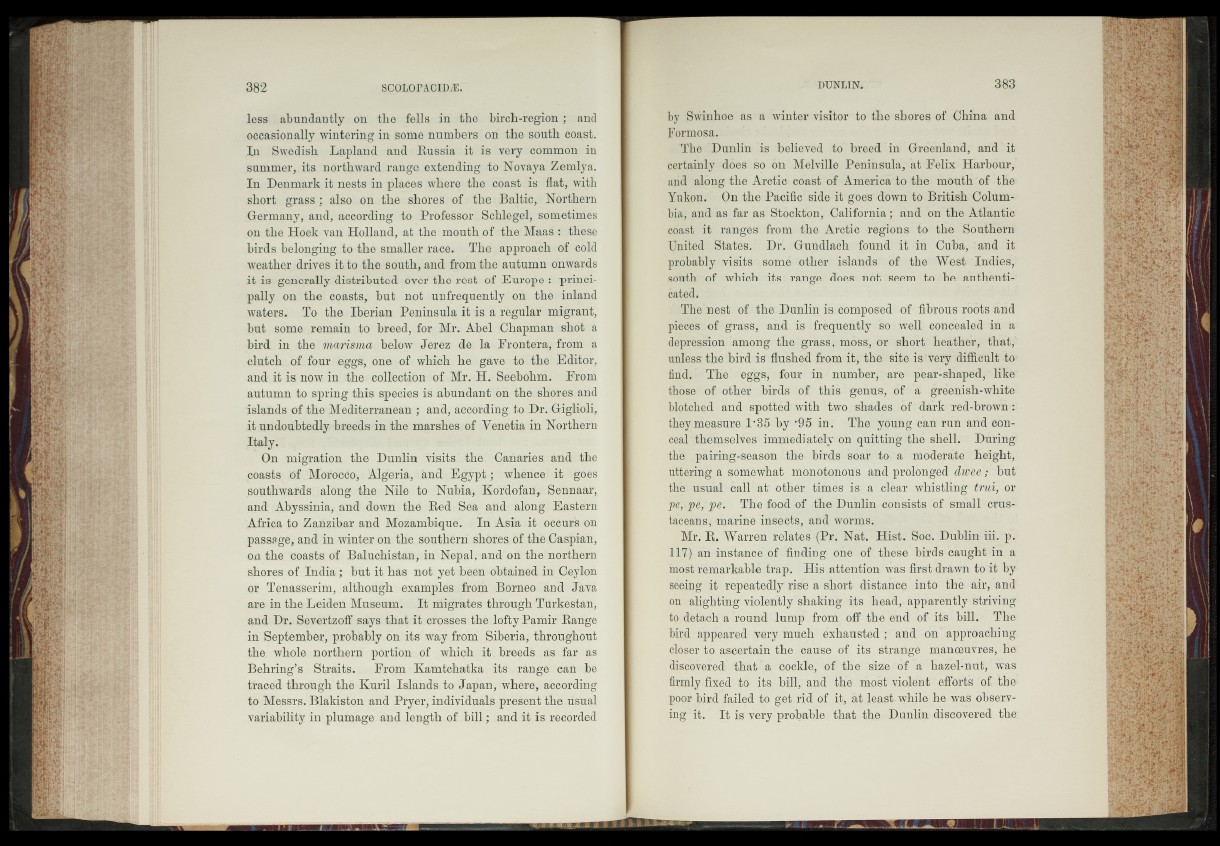
less i abundantly on the fella in the'. birch>region; .and
occasionally wintering in some numbersr on the south coast.
In Swedish Lapland and Russia'. it-.is very common in
summer, its northward range, extending -to Novaya Zemlya.
In Denmark it nests in places where the coast is flat, with
short grass; also on the shores of the Baltic,. Northern
Germany, and, according to Professor | Schlegei, sometimes
on the Hóek van Holland, at the mouth of "the Maas^:- itbese
birds belonging to the smaller race. The approach of 'cold
weather drives it to the south, and from the autumn onwards
it is generally distributed over the rest-of Europe;.:' principally
on the coasts, but not .uofrequently'©if -thé inland
waters. To the Iberian Peninsula it is a regular migrant,
but some remain «to breed, for Mr. Abel ^Chapman shot a
bird in the marisma,. below Jerez- de: la; Fr outer a,> from a
clutch .of four eggs, One of which,he gave toTtheiEditor,
and it is now in the collection Mr. H.- Seebohni. -Prom
autumn to spring this species is abundant-oh the shores'and
islands of the Mediterranean ; and, according-to Dr.-Gigiioli,
•it undoubtedly breeds in the marshes of Yenetia in Northern
Italy.
On migration the Dunlin 'visits Hhe" Canaries an&ï'the
^coasts of Mosoecoj Algeria,' and Egypt,-; whèhce;.it-t§oes
southwards along-the üiledto Nubia/.Eordofanjiliebnaar,
and; Abyssini^ and down the-iReêoStéfa' artdrialong^-Eastern
Africa tW^anzibar and Mozambique^ Asia it;oceuifem
passage, and in winter on, tHet-southerh shores of the .Caspian,
on the coasts of Baluchistan, in Nepal, and oh the:northern
shores of India; but it has noteyekbesam obtained -inpsfeyïon
or Tenasserim, .although examples from BorneoSand. J a il
are in the Leiden Museum. It migrates -through'Thitestan,
and Dr. Severtzoff-says, thafatf-.crösses theJoffcyPamir Range
in September, probably bn its 'way" from Siberia,- throughout
the, whpj& northern portion „of ,\which. it I breeds .as far as
Behring’s StraitSi ., Prom Kamtchatka its grange cancbe
traced throiigh'thè Kuril Islands; t® Japan, where?,,-according
to Messrs. Blakiston and Pryer, individuals present the usual
variability in plumage and length of. bill; and ï t is recórdéd
by Swinhoe as‘a winter visitor to" the shores of China and
Formosa. ' ' - .
"The Dunlin is .believed to breed in Greenland; and ' it
certainly d©ess<so bn Melville Peninsula, at Felix Harbour,
and along, the Arctic; coast of America t®the mouth of -the
Yukon. On the Pacific side it goes down tô 'British',Cokim->
bia, and as far as Stockton^ California and on the Atlantic1
coast -lit’'ranges from !th’e Arctics regions? tV the Southern
United? States. Dr . Gundlach found it in Cuba, ; and it
probably visits some -:oth'er//islahdsr @f -the' West‘Indies^
south of which its, range .'«toessmot .seem rto-fbet authentic
bated; 5
Them est''of the Dunlin is’composed ^of fihrous:rb®te and
pieces.: o£-:gras®/< and is*?frequently? ite -,Well ooncealed in a
bteprèssîon"among the grass, moss, or short*'heather, thut^
unless; the bird is flushed from it, the^site is;very difficult -to>
find. -*The eggs, four -in. numhe#|y;arè> pear-shaped,- like
those” of other birds gehttS, of a greenish-white?
bitched and spotted" with two shades of - dark red-brown ^
thewmeasure 1 ;,SAby?'93 in. The. young ^ansrifii and conceal
7,the m selves * immediately on qfrdfttirfgthé sHelh During
the .fairing-season Silie‘/birds? 's®àr. 'to-'a moderate''freight,'
utterir g A somewhat mon^oeÿq.s and prolonge# But
fhéî.4isüal' callafe other "times is a Ml an. whistling - truly-pv.
péfifëër' The food’Of the Dunlin .^pn "sistsjjÉf small 'crustaceans,
daâïîàeunSe''|te, and worms J
,Mr. R. Warren relates- (Pi. Nat/ffibt: Sue.'Dublin iii. p.
11-7) an insta’ncd of. fin d iS one"Jof ;‘tpMe birds GaUght in a
most remarkablëifrapl Hisoattentfonjfrvas first drawn to it by>
seeing!it: repeatedly?risfe E-short' distafeef tnto'dfre -air, and?
ôn^llightin''g?v%l€Ëillyrshaking lits head,-apparent^.'Striving'
to detech abound, lunip/froiA' bff: the'end- of itsU^htd The
Mrd ap^arejîfWeryfiquc^ exhausted and on ' approaching^
.cjfser to .ascertain the caio.se of iteJstrangé« manoeuvres, fre?
dfebovered that "a' c o c k l e , t b o -»si'/esJ of a frazeliUut?/ was
firmly, fixed? to its'bill, and the : most* violent rVleflbits: "of thëP
nopr))ird failed to. get,rid of It, at least.while-he. was observing^
it.' It is ielyprobable that tbo Dunlin- disooyered the;